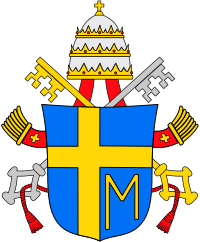Pope John Paul II's visit to Ireland
.jpg)
Pope John Paul II's visit to Ireland from Saturday, 29 September to Monday, 1 October 1979 was the first visit by a pope to Ireland.[1] Over 2.5 million people attended events in Dublin, Drogheda, Clonmacnois, Galway, Knock, Limerick, and Maynooth. It was one of Pope John Paul's first foreign visits. The visit was occasioned by the centenary of the reputed apparition of Blessed Virgin Mary, Saint Joseph, and Saint John the Evangelist in Knock, County Mayo.
Key Figures
Prominent members of the Irish clergy involved in different aspects of the event included Cardinal Tomas O'Fiaich, the Archbishop of Armagh; Monsignor James Horan, the Parish Priest of Knock; Bishop of Galway, Eamonn Casey and broadcaster Father Michael Cleary.
Visit
Saturday, 29 September
An Aer Lingus Boeing 747, named the St Patrick, brought Pope John Paul II from Rome to Dublin airport. The Pope kissed the ground as he disembarked.[2] After being greeted by the President of Ireland, Dr Patrick Hillery, the Pope flew by helicopter to the Phoenix Park where he celebrated Mass for 1,250,000 people, one quarter of the population of the island of Ireland, one third of the population of the Republic of Ireland. Afterwards he travelled to Killineer, near Drogheda, where he led a Liturgy of the Word for 300,000 people, many from Northern Ireland. There the Pope appealed to the men of violence: "on my knees I beg you to turn away from the path of violence and return to the ways of peace". The Pope had hoped to visit Armagh, but the security situation in Northern Ireland rendered it impossible. Drogheda was selected as an alternative venue as it is situated in the Catholic Archdiocese of Armagh. Returning to Dublin that evening, the Pope was greeted by 750,000 people as he travelled in an open top popemobile through the city centre and visited Aras an Uachtarain, the residence of the Irish President.[3]
Sunday, 30 September

Pope John Paul began the second day of his tour with a short visit to the ancient monastery at Clonmacnois in County Offaly.[4] With 20,000 in attendance, he spoke of how the ruins were "still charged with a great mission".[5] Later that morning he celebrated a Youth Mass for 300,000 at Ballybrit racecourse in Galway. It was here that the Pope uttered perhaps the most memorable line of his visit: "Young people of Ireland, I love you". That afternoon, he travelled by helicopter to Knock Shrine in County Mayo which he described as "the goal of my journey to Ireland". The outdoor Mass at the shrine was attended by 450,000. The Pope met with the sick and elevated the church to the title of Basilica.
Monday, 1 October
The final day of the visit began with a trip to St Patrick's College, Maynooth, the National Seminary, in County Kildare. Some 80,000 people packed the grounds of the college for the brief visit. A dense fog delayed the Pope's arrival from Dublin by helicopter. The final Mass of the Pope's visit to Ireland was celebrated at Greenpark Racecourse in Limerick before 400,000 people, many more than had been expected. The Mass was offered for the people of Munster. Pope John Paul left Ireland from nearby Shannon airport travelling to Boston where he began a six-day tour of the United States.[2]
Response
Support
c.10% of the boys born in Ireland in 1980 were named "John Paul".[6]
See also
References
- ↑ "Irish Remember the 1979 Papal Visit". BBC News. 2 April 2005. Retrieved 4 August 2014.
- 1 2 "Pope John Paul II's Irish visit (Slideshow)". Irish Times. Retrieved 25 October 2014.
- ↑ "Canonisations to be marked across Ireland". Irish Times. 26 April 2014. Retrieved 8 August 2014.
- ↑ Harbison, Peter (1 April 1995). Pilgrimage in Ireland: The Monuments and the People. New York: Syracuse University Press. p. 117. ISBN 978-0-8156-0312-2.
- ↑ "Clonmacnoise youth festival draws the crowds". Athlone Advertiser. 21 August 2009. Retrieved 28 August 2014.
- ↑ Why names will never hurt the social climbers David McWilliams, 2006
